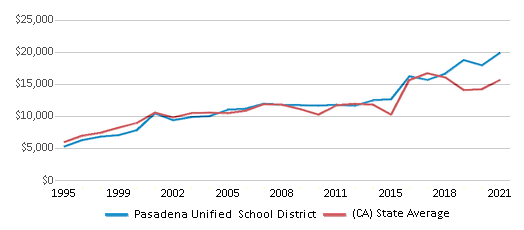Top Rankings
Pasadena Unified School District ranks among the top 20% of public school district in California for:
Category
Attribute
Community Size
Largest student body (number of students) (Top 1%)
For the 2025 school year, there are 6 public high schools serving 5,791 students in Pasadena Unified School District. This district's average high testing ranking is 7/10, which is in the top 50% of public high schools in California.
Public High Schools in Pasadena Unified School District have an average math proficiency score of 28% (versus the California public high school average of 28%), and reading proficiency score of 47% (versus the 51% statewide average).
Public High School in Pasadena Unified School District have a Graduation Rate of 89%, which is more than the California average of 87%.
The school with highest graduation rate is Marshall Fundamental, with 96% graduation rate. Read more about public school graduation rate statistics in California or national school graduation rate statistics.
Minority enrollment is 83% of the student body (majority Hispanic), which is more than the California public high school average of 79% (majority Hispanic).
Overview
This School District
This State (CA)
# Schools
23 Schools
2,817 Schools
# Students
13,854 Students
2,139,525 Students
# Teachers
645 Teachers
100,737 Teachers
Student : Teacher Ratio
21:1
21:1
District Rank
Pasadena Unified School District, which is ranked #800 of all 1,925 school districts in California (based off of combined math and reading proficiency testing data) for the 2021-2022 school year.
The school district's graduation rate of 89% has increased from 85% over five school years.
Overall District Rank
#791 out of 1941 school districts
(Top 50%)
(Top 50%)

Math Test Scores (% Proficient)
33%
33%

Reading/Language Arts Test Scores (% Proficient)
45%
47%

Science Test Scores (% Proficient)
30%
29%
Graduation Rate
89%
87%

Students by Ethnicity:
Diversity Score
0.62
0.63
# American Indian Students
22 Students
10,468 Students
% American Indian Students
n/a
1%
# Asian Students
1,058 Students
244,247 Students
% Asian Students
8%
11%
# Hispanic Students
8,053 Students
1,190,384 Students
% Hispanic Students
58%
56%
# Black Students
1,392 Students
110,575 Students
% Black Students
10%
5%
# White Students
2,391 Students
458,887 Students
% White Students
17%
22%
# Hawaiian Students
20 Students
9,060 Students
% Hawaiian Students
n/a
n/a
# Two or more races Students
888 Students
108,483 Students
% of Two or more races Students
7%
5%
Students by Grade:
# Students in PK Grade:
-
18
# Students in K Grade:
1,309
25,126
# Students in 1st Grade:
915
19,346
# Students in 2nd Grade:
1,012
19,826
# Students in 3rd Grade:
1,041
19,554
# Students in 4th Grade:
991
19,798
# Students in 5th Grade:
1,031
20,237
# Students in 6th Grade:
1,007
29,089
# Students in 7th Grade:
1,011
39,371
# Students in 8th Grade:
1,097
41,955
# Students in 9th Grade:
1,004
466,491
# Students in 10th Grade:
1,152
476,582
# Students in 11th Grade:
1,091
469,509
# Students in 12th Grade:
1,193
492,623
# Ungraded Students:
-
-
District Revenue and Spending
The revenue/student of $21,785 is higher than the state median of $19,974. The school district revenue/student has grown by 9% over four school years.
The school district's spending/student of $18,252 is less than the state median of $18,396. The school district spending/student has grown by 9% over four school years.
Total Revenue
$302 MM
$116,387 MM

Spending
$253 MM
$107,188 MM

Revenue / Student
$21,785
$19,974

Spending / Student
$18,252
$18,396

Best Pasadena Unified School District Public High Schools (2025)
School
(Math and Reading Proficiency)
(Math and Reading Proficiency)
Location
Grades
Students
Rank: #11.
Pasadena High School
(Math: 29% | Reading: 61%)
Rank:
Rank:
7/
Top 50%10
2925 East Sierra Madre Blvd.
Pasadena, CA 91107
(626) 396-5880
Pasadena, CA 91107
(626) 396-5880
Grades: 9-12
| 1,355 students
Rank: #22.
Marshall Fundamental
(Math: 32% | Reading: 48%)
Rank:
Rank:
6/
Top 50%10
990 North Allen Ave.
Pasadena, CA 91104
(626) 396-5810
Pasadena, CA 91104
(626) 396-5810
Grades: 6-12
| 1,848 students
Rank: #33.
Blair High School
(Math: 28% | Reading: 43%)
Rank:
Rank:
6/
Top 50%10
1201 South Marengo Ave.
Pasadena, CA 91106
(626) 396-5820
Pasadena, CA 91106
(626) 396-5820
Grades: 6-12
| 1,055 students
Rank: #44.
Cis Academy
Alternative School
(Math: 25-29% | Reading: 35-39%)
Rank:
Rank:
5/
Bottom 50%10
2925 East Siera Madre Blvd.
Pasadena, CA 91107
(626) 396-5883
Pasadena, CA 91107
(626) 396-5883
Grades: K-12
| 235 students
Rank: #55.
John Muir High School
(Math: 10-14% | Reading: 45-49%)
Rank:
Rank:
4/
Bottom 50%10
1905 North Lincoln Ave.
Pasadena, CA 91103
(626) 396-5600
Pasadena, CA 91103
(626) 396-5600
Grades: 9-12
| 1,133 students
Rank: #66.
Rose City High (Continuation School)
Alternative School
(Math: ≤10% | Reading: ≤10%)
Rank:
Rank:
1/
Bottom 50%10
351 South Hudson Ave.
Pasadena, CA 91101
(626) 396-5620
Pasadena, CA 91101
(626) 396-5620
Grades: 9-12
| 165 students
Recent Articles

What Is A Charter School?
Explore the world of charter schools in this comprehensive guide. Learn about their history, how they operate, and the pros and cons of this educational innovation. Discover key facts about charter schools, including admission policies, demographics, and funding, as well as what to look for when considering a charter school for your child.

10 Reasons Why High School Sports Benefit Students
Discover the 10 compelling reasons why high school sports are beneficial for students. This comprehensive article explores how athletics enhance academic performance, foster personal growth, and develop crucial life skills. From improved fitness and time management to leadership development and community representation, learn why participating in high school sports can be a game-changer for students' overall success and well-being.

February 05, 2025
Understanding the U.S. Department of Education: Structure, Impact, and EvolutionWe explore how the Department of Education shapes American education, from its cabinet-level leadership to its impact on millions of students, written for general audiences seeking clarity on this vital institution.





